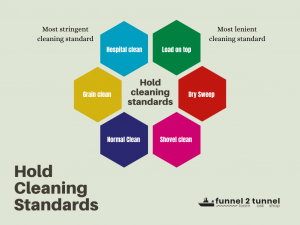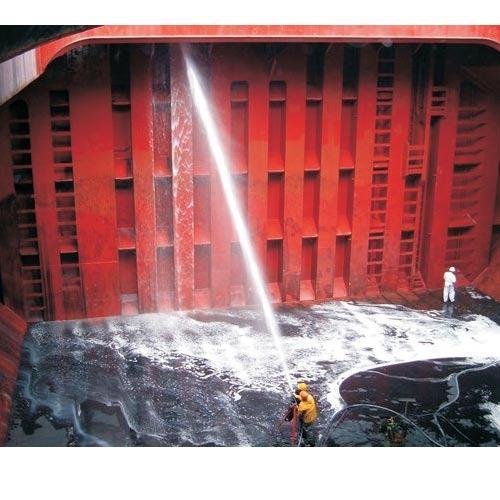Everything you need to know about Grain Loading | Pre loading preparations | Part II
June 16, 2021Never ignore these nine things on Hatch Covers
August 1, 2021
Hold cleaning is one of the most critical operation onboard. The kind, type, duration and level of cleaning will primarily depend upon the type of cargo the vessel is suppose to load. In previous blog, we have discussed in detail regarding the grain loading preparations.
Read about the grain loading here
In continuation with the topic, it will now be prudent to discuss the hold cleaning standards which every officer should be aware. This will help you in planning the resources efficiently and avoid spending additional time in cleaning holds for cargoes which do not require intense cleaning for their carriage. The aim of this topic is to make you aware about the hold cleaning standards which are prevalent as far as cargo carriage by sea is concerned.
So let us move ahead, and learn about the Hold cleaning standards which will help you in planning for your next cargo loading –
Important note: Cleaning standards mentioned below are based on widely accepted criteria for hold cleaning among concerned organizations including P and I clubs. Master should always consult the owners and charters in order to ensure that the required cleaning standards are met as required by the cargo required to be carried.
Hold cleaning standards
In the Bulk trade there are essentially five types of Hold cleaning standards –
-
Hospital clean
-
Grain clean
-
Normal clean
-
Shovel clean
-
Dry sweep
-
Load on top
As it may be clear, the hospital clean is the highest standard of cleaning while the load on top is the lowest. We shall discuss each standard in detail.

Hospital Clean : Hospital clean is the most stringent cleaning standard. It requires the paint coating in the holds to be 100% intact on all surfaces including the tank top, all ladder rungs and undersides of hatches.
This type of cleaning is required for cargoes such as kaolin/china clay, mineral sands such as zircon, barytes, rutile sand, ilmenite, fluorspar, chrome ore, soda ash, rice in bulk, and high grades of wood pulp. Generally, these high standards of cleanliness will only be met by vessels trading exclusively with such cargoes. It will rarely be required in the tramp trades.
Grain clean : This is the most common requirement. As the name suggests, this is the cleaning standard which is required for grain cargoes. A ship will be required to be grain clean for the majority of bulk and break bulk cargoes, such as all grains, soya meal and soya products, alumina, sulphur, bulk cement, bauxite, concentrates, and bulk fertilizers. The industry accepted definition for grain clean is provided by the NCB (National Cargo Bureau) –
“Compartments are to be completely clean, dry, odour-free, and gas-free. All loose scale is to be removed.”
As per the definition of grain clean we can deduce that –
-
All past cargo residues and lashing materials (if an) must be removed from the hold
-
Any loose paint or rust scale must be removed
-
the hold must be completely dry after washing and prior loading
-
the hold must be well ventilated and odor free
-
the holds should pass the ‘white glove test’ in which no visible residues should come off the hold surface when white cloth is rubbed against the hold surface
Normal clean : Normal clean means that the holds are swept clean, with no residues of the previous cargo, and washed down (or not, depending on charterer’s requirements), that is, cleaned sufficiently for taking cargoes similar to or compatible with the previous shipment.
Shovel clean : Shovel clean means that all previous cargo that can be removed with a ‘Bobcat’ or a rough sweep and clean with shovels by the stevedores or crew.
Dry sweeping : Dry sweeping means that all accessible areas such as ladders and hoppers and the tank top have been thoroughly swept. All the visible residues of the previous cargo have been removed.
Load on top : in load on top standard, the cargo is loaded on top of existing cargo residues. Usually, this means ‘grab cleaned’. This standard will commonly be required where a ship is trading continuously with the same commodity and grade of that commodity. This will typically occur when a ship is employed under a Contract of Affreightment to carry, for example, a single grade of coal over a period. With such a trade, there is no commercial need for holds to be cleaned between successive cargoes, and each cargo is simply loaded on top of any remaining residues from the previous cargo. With load on top, guidance may be necessary for the master on any cleaning requirements, including the use of bulldozers and cleaning gangs.
By now, you must be well aware of the different hold cleaning standards which may be required for different types of cargo. In all cases, the Master shall in consultation with Owners – ask the Charters to clearly inform the vessel regarding the standard of hold cleaning required by the cargo planned to be loaded. Knowing this not only saves time but also ensures that resources are mobilized effectively especially when the time factor is crucial.
Wishing you fair seas and bonn voyage!
Follow us on –







1 Comment
[…] Hold cleaning requirements – Most of the general cargoes carried are finished products transported for end-use. Hence, the hold cleaning requirements are usually pretty stringent. Imagine a cargo of paper pulp, which requires absolutely shining holds. On the other hand, carriage of cargo such as steel coils may require a normally cleaned hold. Many a time, general cargo may also carry bulk cargoes such as chemicals, grain or specialized concentrates. The cleaning standards may vary for different cargoes. You should seek charters guidance regarding hold cleaning requirements for the cargo intended to be carried. This shall be asked in sufficient time so that required equipment and paints can be sourced in time. To read about various hold cleaning standards, click here. […]